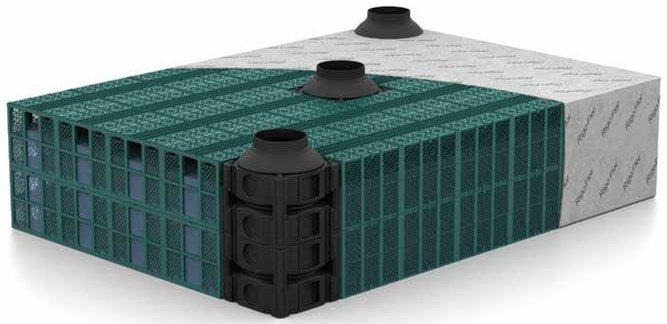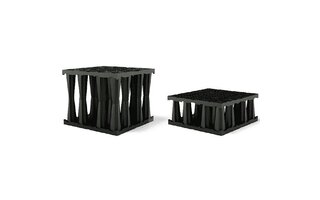You have no items in your shopping cart
Infiltration crates
Infiltration crates: sustainable solution for rainwater management and water infiltration
As a company or organization, you are probably looking for effective ways to manage rainwater in a sustainable way. Flooding can cause serious damage to infrastructure and environments, while droughts can deplete water reserves. These crates offer an innovative and sustainable solution to efficiently manage rainwater. At DWTN, we offer crates that help collect and infiltrate rainwater without increasing the pressure on the sewer network. Read on to discover how we can improve your rainwater management.
What are infiltration crates?
Infiltration crates are plastic crates used in an infiltration system to collect rainwater and allow it to slowly infiltrate into the ground. They are designed to store water and then drain it away through the ground. They can handle a significant amount of rainwater, even during heavy rainfall, which significantly reduces the risk of flooding . They are ideal for both commercial and industrial applications, such as car parks, business parks and urban infrastructure.
Advantages of infiltration crates
Efficient rainwater management : These crates help to efficiently drain rainwater to the ground, preventing water from accumulating on the surface and causing damage.
Sustainability : These crates are made from recycled plastic, making them both environmentally friendly and sustainable.
Easy Installation : Our ready-to-use crates are easy to install and can be put into use quickly without the need for complicated adjustments.
Raised groundwater level : By allowing rainwater to infiltrate into the ground, you contribute to restoring the groundwater level, which is important for the long-term availability of water sources.
Less pressure on sewer networks : Instead of rainwater flowing into the sewer, it is absorbed into the ground, which relieves the sewer system.
Infiltration crates: different variants and capacities
Our infiltration crates are available in a range of sizes and capacities depending on the size of the project. The 400 litre , 600 litre , 800 litre and 1000 litre variants are a popular choice for smaller sites, while larger crates with a capacity of over 1000 litres are ideal for larger areas such as car parks and industrial sites. Our infiltration crates are suitable for a wide range of applications from residential to industrial use .
Specifications of our infiltration crates:
Capacity : Ranging from 400 liters to several thousand liters, depending on the size of the project.
Material : Made of PP or recycled plastic , which ensures durability and a long lifespan.
Size : Depending on the project requirements, the infiltration crates can be stacked or combined to handle larger volumes of rainwater.
Water permeability : The crates are designed for optimum water permeability , allowing rainwater to infiltrate quickly without clogging the system.
Our solution: ready-to-use infiltration crates
At DWTN we offer ready-made infiltration crates that are easy to install. Whether you have a small project or a large industrial site to tackle, we have the right solution. Our infiltration crates are designed to be installed quickly and effectively, so you can start managing rainwater without worry.
Easy installation : The infiltration crates can be easily connected and quickly buried in the ground.
Safe and reliable : Our systems are tested and meet the highest safety and quality standards.
Applications of infiltration crates
Our infiltration crates are suitable for various applications:
Parking lots : Manage rainwater effectively and prevent flooding by installing infiltration crates under parking lots.
Industrial sites : Prevent flooding and restore groundwater levels by efficiently managing rainwater on industrial sites.
Residential Areas : Provide a safe and sustainable solution for rainwater management in residential areas, gardens and parking lots.
Urban infrastructure : Infiltration crates are ideal for draining rainwater in urban environments, such as streets and sidewalks.
Installing infiltration crates: what should you pay attention to?
When installing infiltration crates there are a number of important considerations:
Soil type : The type of soil plays a major role in the effectiveness of the infiltration system. For example, sandy soil is ideal for infiltration , while clay soil is less suitable.
Water permeability : Ensure that the system is well-drained so that water can infiltrate quickly.
Dimensions and Capacity : Choose the right capacity of the infiltration crates based on the amount of rainwater you want to collect.
At DWTN we offer advice and guidance to ensure your infiltration crates are installed correctly for optimal results.
Customer cases: infiltration crates in action
DWTN has worked with various companies and municipalities to provide infiltration crates for both small and large scale projects. From rainwater management in parking lots to improving groundwater levels in urban areas, our infiltration crates provide proven results. View our customer cases to learn more about the effectiveness of our solutions.
Frequently asked questions about infiltration crates
- What is the lifespan of infiltration crates?
The lifespan of these crates depends on the environment and use, but generally they can last for decades, especially if properly installed and maintained. - How much rainwater can an infiltration crate collect?
The capacity of an infiltration crate varies, but they can store hundreds to thousands of liters of rainwater depending on the size and design of the system. - Can I install infiltration crates myself?
Yes, infiltration crates can be installed by a professional or experienced installer. At DWTN we offer customized solutions where we also support you with the installation.
Please contact us for more information or a quote
Are you ready to invest in a sustainable infiltration system for your project? Contact us for more information about our infiltration crates .




